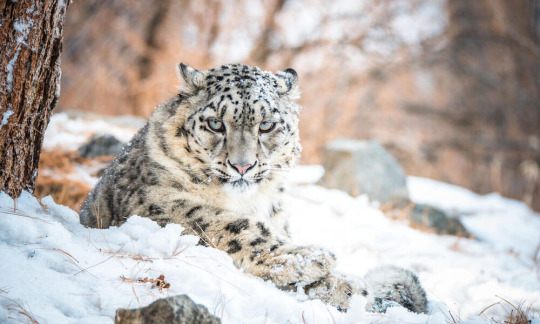#multitudes (cares about seneca)
Text
everyione shut the fuck up john simm played caligula this is a category 1000 ulrike event
#on GOD i am going to watch this shitty 2004 television movie about nero for you john simm as caligula. good LORD#eta okay i cant fucking find it anywhere for free so if u have a link hit me up.. idc that john simm is only in it for two seconds i contai#multitudes (cares about seneca)#shut up ulrike#john simm#rome
5 notes
·
View notes
Text
Animals
Hello again everybody!! I hope you well and still taking care of the pandemic, today we’re gonna talk about animals, first I tell you all about mines, my favorite animals. Anyway, we’ll start, you ready? Good.
These are some of the many animals that I like. Let’s go!!!
SNOW LEOPARD:

The snow leopard has evolved to survive under the most extreme conditions on Earth. Its grayish-white fur with large black spots blends perfectly with the texture of the rugged, rocky mountains of Central Asia.
The snow leopard's powerful anatomy allows it to climb large, steep slopes with ease. Its hind legs give the snow leopard the ability to leap the equivalent of six times its body length. Its long tail provides balance and agility, and also allows the snow leopard to shelter from the cold when at rest.
For thousands of years, this magnificent feline was king of the mountains, where prey such as blue goats, argali, ibex, marmots, rock rabbits and hares abounded. The snow leopard is found in 12 countries, including China, Bhutan, Nepal, India, Pakistan, Afghanistan, Russia and Mongolia, but its population is declining.
SPANISH HORSE:

The true origin of the Spanish Horse is not known for certain, however there is evidence that in pre-Roman times there were equestrian references in what is known today as Spain.
Roman authors such as Plutarch, Pliny the Elder and Seneca speak of the Hispanian horse as a beautiful, docile, arrogant and brave specimen, ideal for war and for the games that took place in the circuses of the time.
King Philip II ordered the horse herd of his kingdom and laid the definitive foundations for the Pura Raza Española to reach its apogee in the years to come. He achieved this through the creation of the Royal Stables of Cordoba, where he grouped together the best stallions and mares from the provinces bordering the Guadalquivir, which at that time were the most prolific in horse breeding.
Thus was born the Yeguada Real, which eventually became the Yeguada Nacional. A multitude of horses were then sent to the American continent, which had a decisive influence on their exploration, and these were the origin and basis of most of the breeds that were later bred in America.
BENGAL TIGER:

Tigers are the largest members of the cat family and are famous for their power and strength.
Bengal tigers, also called Indian tigers, live in India. They are the most numerous tiger species and account for about half of the wild tiger population.
For many centuries they have played an important role in Indian tradition and culture. Tigers live solitary lives and aggressively mark large territories with their scent to keep rivals away. They are powerful nocturnal hunters, capable of traveling many kilometers to find buffalo, deer, wild boar or other large mammals.
Tigers use their distinctive fur for camouflage (no two tigers have the same stripes). They stalk patiently and approach their victims with great stealth just long enough to attack them with a quick and lethal leap. A hungry tiger can eat up to 25 kilograms in one night, although they are usually not so voracious.
That’s all for today guys, I hope you liked it, thaniks, see you all soon everyone! Take care.
3 notes
·
View notes
Text
1906: Rest in Peace Sister Susan

50: Rest in Peace Sister Susan
Susan Brownell Anthony, born in the living room of her childhood home in Adams, MA on February 15, 1820, died at her home in Rochester, NY, on March 6, 1906. Despite working for decades, she never saw the passage of the 19th Amendment which bears her name. (Episode 33)
There is the belief that leaders are just born into the cause, but the truth is that leaders evolve over time. Susan B. Anthony is such a mythological figure in women’s rights that it’s hard to conceive of the fact that she wasn’t always interested in women having the right to vote. In fact, she admitted being unready to vote and didn’t even attend the meeting at Seneca Falls.
The 1848 convention at Seneca Falls (Episode 8) actually had a follow up meeting two weeks later in Rochester, NY. Anthony’s parents and sister, Mary, attended. The next time Susan B. Anthony came to visit them, they told her all about the exciting event. In her opening speech for the Conference of the Pioneers* portion of the International Council of Women Conference (March 31, 1888), Anthony recounted her first reaction to her father's enthusiasm about women having the vote. She laughed and said, “I think you are getting a good deal ahead of the times.” She fully admitted that she originally didn’t want to vote and didn’t feel ready to vote but always wanted equal pay.
Anthony was more involved with the Temperance Movement but when she was barred from speaking in public because of her gender, she began to see suffrage as the best gateway to create real change. Inspired by the speeches of Lucy Stone, she took up the suffrage banner. Her life long friendship with Elizabeth Cady Stanton began in 1851 and both of them have mentioned that were it not for the support of each other through the difficulties, resistance, and ridicule, perhaps they would have given up on the cause.
It can be hard to conceive of Susan B. Anthony ever having been uninterested in the idea of suffrage but that also gives precedent for everyone to allow their views to evolve. There is no glory in the false virtue of remaining consistent to your ideological stances if they don't fit you anymore. Being steadfast and prideful when you realize your current ideology isn’t who you want to be, imprisons you and is a fate far worse than being labelled a “flip-flopper”. When you learn more or see a different perspective, sometimes you change your mind and sometimes you get stronger in your current beliefs. Being open to learning more and then willing to correct or modify your course accordingly, deepens your wisdom and fosters a growth mindset.
Ms. Anthony went from laughing at the idea of suffrage to being it’s most lauded champion, but suffrage only happened because of thousands of unnamed people who supported the cause on an individual level. Working for a cause can’t be done by just the people at the top. They lead the way but it takes a multitude of people to make change happen. If you care about a cause, you can start advocating as soon a you want...right this very moment. You don’t have to be brave, or strong, or well-connected. You just have to care enough to stop being a bystander and manifest your beliefs into action.
Other fun facts about Susan B. Anthony is that she always carried an alligator-skin purse and wore a red silk shawl. The purse, which was a doctor-style bag, was used more like a briefcase as it was constantly filled with letters, pamphlets, and speeches. The original bag is on display at the Susan B. Anthony House Museum in Rochester, NY. The shawl was a practical item in the days before photography was common. Reporters and fans could readily identify her the moment she came into town. Her original shawl is at the Smithsonian’s National Museum of American History in Washington D.C.
This week’s song pick
“Sister Oh Sister” by Rosanne Cash (fan compilation of old family movies) https://youtu.be/6edeYqaQKtQ
#FightForThe19th #SuffragetteCity100
Episode 50 sources:
* “International Council of Women” convention of 1888 with primary source material spoken by Susan B. Anthony and Elizabeth Cady Stanton at the conference. The part of the speech when Anthony discusses her initial reaction to the idea of suffrage (page 327) and Stanton talks about meeting Lucretia Mott at the World Anti-Slavery Convention in 1840 and how people really reacted to Seneca Falls. Staton’s own father thought she had gone insane and travelled all night to make sure she was okay (pages 323-325).
https://books.google.com/books?id=eagEAAAAYAAJ&pg=PA327#v=onepage&q&f=false
*Another primary source for full transcript of the “International Conference of Women”
https://archive.org/stream/ofinternatreport00interich/ofinternatreport00interich_djvu.txt
NY Times Obituary
https://archive.nytimes.com/www.nytimes.com/learning/general/onthisday/bday/0215.html
Susan B. Anthony Birthplace Museum, Adams, MA
https://www.susanbanthonybirthplace.com/
Susan B. Anthony House, Rochester, NY
https://susanb.org/
Shawl on Display
https://americanhistory.si.edu/collections/search/object/nmah_529597
#Fight for the 19th#suffragettecity100#susan b anthony#SBA#alligator purse#jump rope song#19th Amendment#rochester NY#adams Ma#susan b anthony house#susan b anthony birthplace#votes for women#suffrage centennial#celebrate Her#celebrateher#19th at 100#100th anniversary 19th amendment#women's history#red shawl#signature style#seneca falls#Susan B
0 notes
Text
My (albeit cliché) self-help journey
Self-help. I came across these words during my second year of college. I distinctly remembered what caused it, and that cause was like every catalyst of a great epiphany. It was a falling out of friendship. Now I know what you're thinking. A falling out? Isn't that something. Well, bad?
I used to think so. I used to think so differently 2-3 years ago, back when I was... lost? And quite sad. But back to the falling out. I was having a deep conversation with my friend about anxiety. She and I became friends because we had the same reaction and general attitude towards life; we were both anxious people. In the course of our friendship, I realized how my anxiety would double, or sometimes triple, when she was around, or when I talked to her. So then I opened up. I told her I might have anxiety, you know, the mood disorder. A mental handicap, as I thought it was. And I, thinking that she would say as well that she had anxiety, was surprised because her next words were, "I don't want to say I have anxiety because once I say it, it might become who I am."
And that scared the fuck out of me. Imagine, just discovering that I was more neurotic, more anxious, than the average person. That I reduced myself to just being anxious. That was both eye-opening and heartbreaking. Because a single thought popped into my brain the moment, she said it, "If I wanted to get into the bottom of my anxiety, I couldn't be friends with someone who denies that they might have it." And from then on, our friendship withered.
Did I regret what I did? Yes and no. I regretted ghosting her. I regretted not telling her my plans for solving my anxiety. I regretted distancing myself away from her, which caused a multitude of problems. But would I do it again? Absolutely. 100%. It's not even a challenge for me because that experienced spurred me on towards my personal, self-improvement journey. So naturally, I started researching. And I came across books and articles that talked about strategies I can do to curb anxiety, about how someone even develops unnecessary fear, about people who have it and how they deal with it.
I can this V1 of my self-improvement. Because these were the first steps I made into becoming a better person. For 2-3 years, my main goal was reducing my anxiety by using tried and tested strategies that works. And for a while, it did. But here's the thing with self-improvement. You. Can't. Stop. Once I got into the hole of researching strategies to curb anxiety, I introduced myself to self-care. I introduced myself to Cognitive Behavioral Therapy. I introduced myself to Productivity, Mindfulness, and Work. To minimalism, to failure, to positive thinking. And I am grateful that I have the resources to research all these things and apply them into my life incrementally. I could feel and see myself getting better and better from my sorry bout back in 2016-2017.
That was all V1. Now I'm on V2. I say this is version 2 because although I discovered a lot more than strategies for anxious people, like self-care and productivity, they were all somehow linked to my initial goal of not entirely eradicating anxiety, but learning how to manage it. They were all geared towards that end. But version 2 of my self-help journey is altogether different, in terms of standards.
Version 2 was this: being a virtuous person. And guess when it started? The latter half of May 2019. So basically, fairly recently. I see my version 1 of my self-help journey as just looking inward as only using strategies that would work for and by myself. But eventually, I grew out of it. Now, in version 2, I look not only inwards, but outwards to how my actions affect other people, how my thoughts influence other people. And version 2 was highly influenced by Stoicism. If you don't know Stoicism, read about it on NJLifeHacks, Ryan Holiday (The Daily Stoic), and Tim Ferris to name a few personalities that have articles online about it. Read Marcus Aurelius' Meditations, Epictetus' The Enchiridion, and Seneca's Letters from a Stoic. Read Ryan Holiday's The Obstacle is the Way and Ego is the Enemy. Those are books and online articles that will help you with the philosophy of Stoicism.
So right now, I'm on the beginnings of version 2, and it feels great. I think the newness, the feeling of being at the edge of discovery—the same feeling I had when I first embarked on my version 1 of self-help.
I'm not sure why I decided to document this. Part of it was because I didn't want to forget my roots how I started. I wanted it to be on a platform that is virtually immortal, so I can look back and see how far I've come.
And how far I'm excited to go.
#stoic#self-help#self-care#stoicism#self-help journey#productivity#minimalism#mindfulness#work#article
0 notes